Let’s be real: kids’ room clutter is the gift that keeps on giving. And it’s not just kids’ bedrooms that are problems — we always find the need to declutter our entryways, the kitchen, the bathroom, the garage, the area around the TV, every corner of every room…you get it. And if you live in a smaller space (hello, city living), the clutter can seem ten-fold. So we’ve been looking for some easy ways to declutter kids’ rooms, which makes for a perfect summer project, as you get a respite from all the classwork and art projects coming home each day.
We spoke with Emma Gordon, an LA-based organizing and storing expert at Clutter.com — and a parents’ best friend — for her own expert tips on how parents can keep our homes (relatively) free of clutter.
Here, we’ve put together 7 of Emma’s most creative pro tips for decluttering kids’ rooms. Hope they keep you just a little more sane!
CMP is an rstyle affiliate
Related: How to create an organized craft space for kids: 7 expert tips
1. Create a toy rotation bin.
Studies actually show that children get more fulfilling playtime when they are not overwhelmed by toy choices. So grab 2-3 plastic bins and start filling them with the groups of toys that your child’s not “into” at the moment. Maybe one for dinosaur figurines, one for dollhouse figures, one for American Girl Doll clothes, you name it.
Store the bins up in a linen cupboard or in a large closet with the goal of keeping them out of sight.
Not only does it make day-to-day cleaning easier when there are fewer toys around, but you can bring those toys back into rotation the next time your kids start asking for new ones, and everything feels new again.
2. Add some novelty to the toy storage.
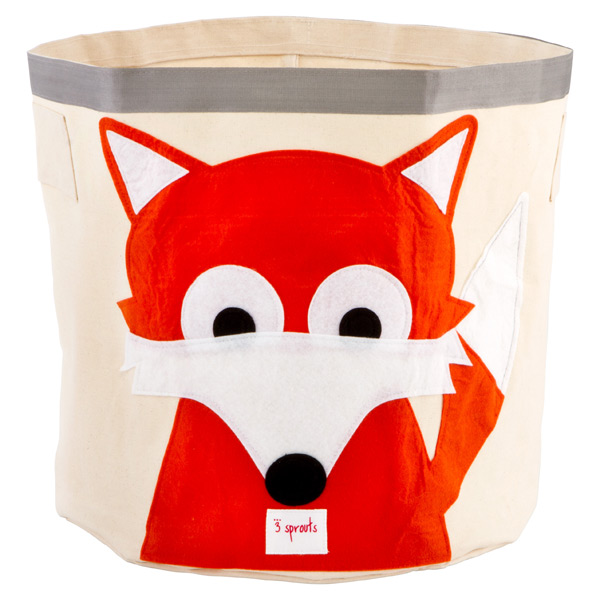
If you want kids to help with cleaning up after playtime — which they should — cleaning gets way more fun for kids when the toy storage itself is playful. This could be as simple as investing in some fun storage baskets or large bins that reflect your kids’ style and interests. The fun animal character fabric bins from 3 Sprouts are a longtime CMP favorite, especially for younger kids.
Also consider surprising decor “tricks” like painting a house on the wall behind the stuffed animal shelf, so the animals can “go home” after playtime. Cool peel and stick wall decals can make it even easier.
Or add a basketball hoop over the toy chest for gamifying the entire clean-up process.
3. Make the closet kidproof. (That’s easier than it sounds.)
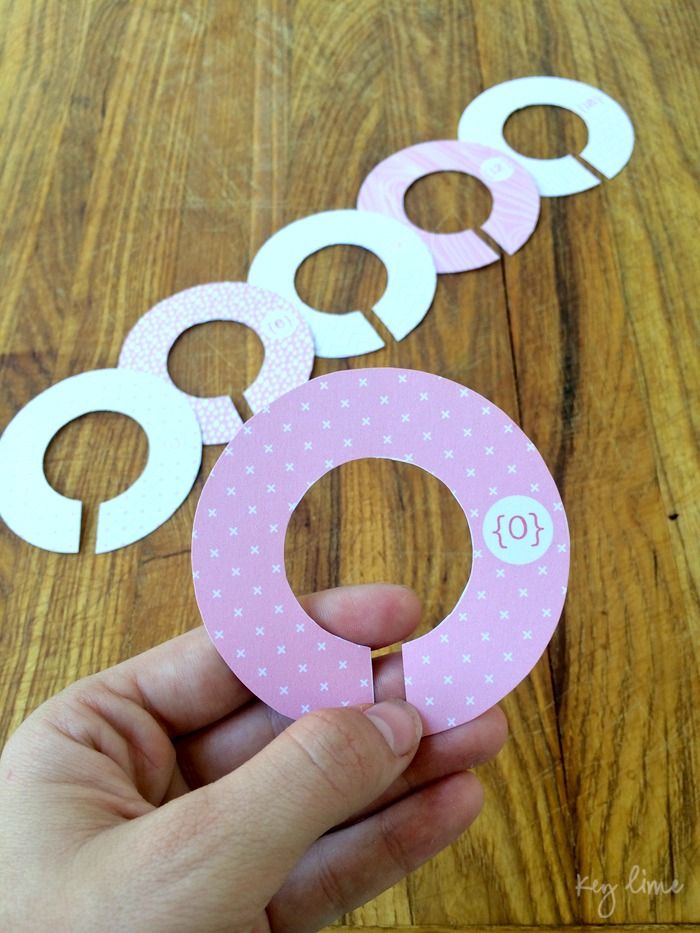
Kids have a remarkable ability to make an absolute mess while trying to “help.” If you want to make it easier on your children — and yourself — consider designing a closet that is difficult to mess up in the first place. It can be done!
A few ways: If your daughter likes to pull out her favorite white summer dress at the first snowstorm, put away out-of-season clothes to stave off the temptation, and rotate them back in when it’s time. If you have younger children, keep their folded clothes on shelves that are out of reach, so helpful littles can’t pull all the clean laundry onto the floor while attempting to dress themselves. Or add a second curtain rod at just the right height, and use it to hold just a few seasonal outfits there for, limiting the number kids can choose from — and deposit on the floor after they’re rejected.
You can also add closet dividers to separate by age or by season — the free printable closet dividers shown here from Kendra John may do the trick. Just use the generic template, then label by season or occasion — sports, weekend, school, dressy.
Related: The KonMari method of tidying: Does it really work for families?
4. Use picture labels on toy bins and drawers featuring the actual items inside.
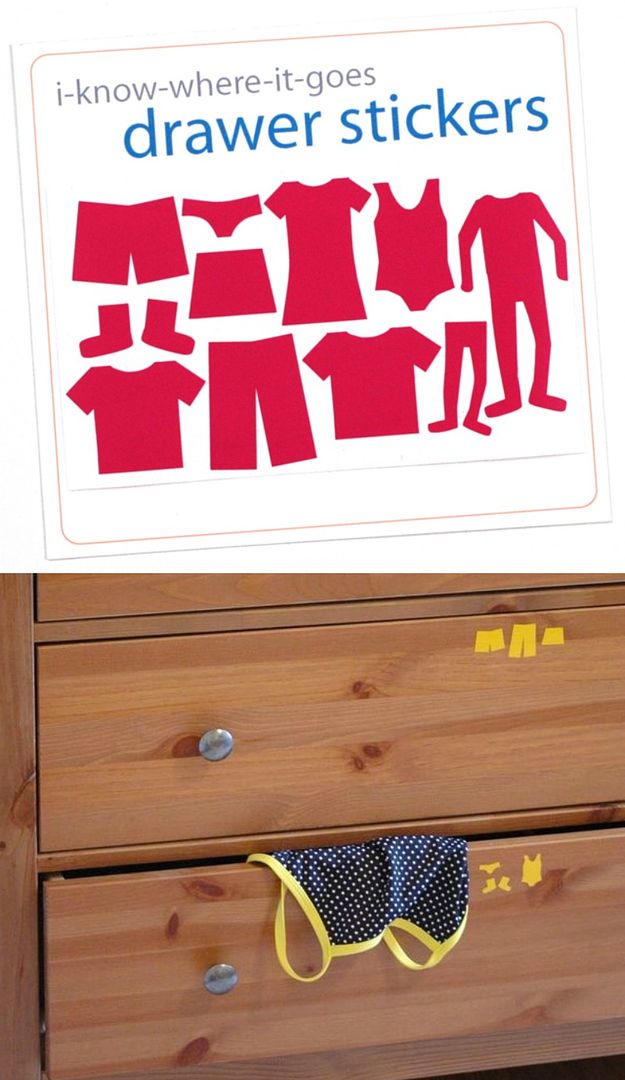
We’ve recommended graphic peel-and-stick drawer organizer labels to help kids know just where to put away which clothes, and the same goes for decluttering toys. It’s much easier for young kids to match things visually, and when the image is bright and appealing, putting away toys can turn into a fun game.
Instead of ordering labels, you can also use photos you take of your kids’ own toys, or just print right from a quick Google image search. For instance, take a photo of their latest LEGO creation and use that as the label for their LEGO bricks container.
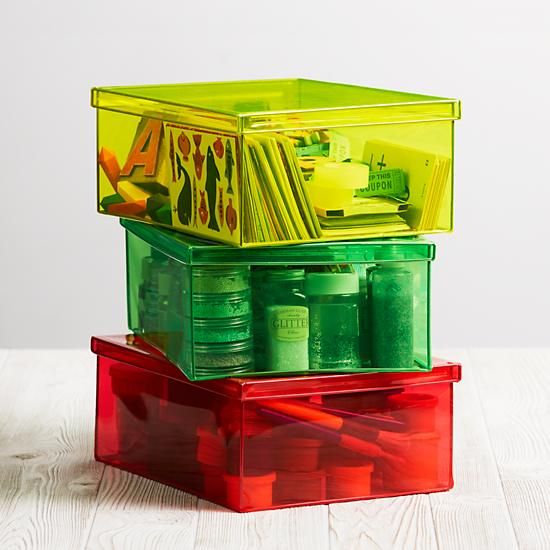
Also, choose bins that you can see through, whether colorfully tinted or clear. While it may not look quite as “clean” as opaque bins, it does help kids stay organized so they can more easily find their materials, toys, or art supplies — and then, put them away.
You can find lots of great translucent or transparent plastic bins at the Container Store. Look for ones that stack well and bonus if they add a pop of color to your playroom or kids room.
5. Unused wall space makes fantastic book storage.
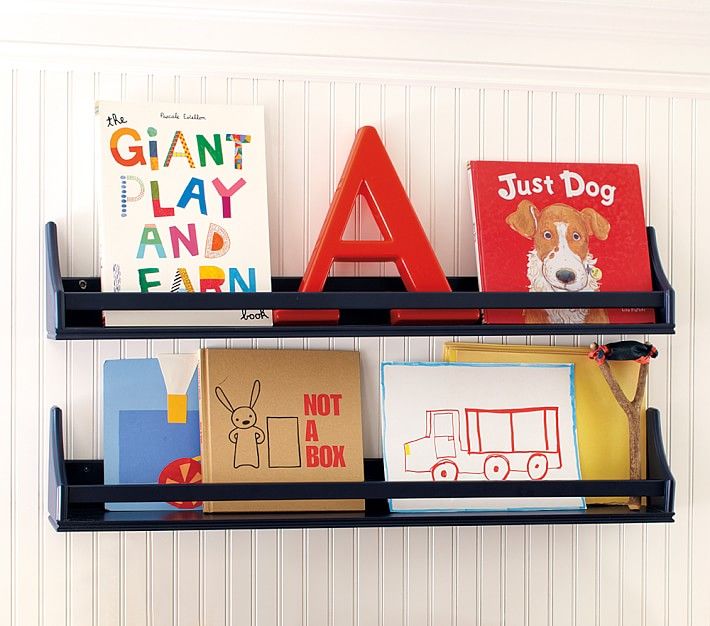
We all want to create more floor space for kids to play, which means getting more of their stuff off the ground. You can save floor space by installing narrow book ledges, like this collectors’ shelf from PBK, then line up your kids’ most-read books on them with the covers facing out. This makes it so easy for kids to find the books they want — from a limited selection — which means they don’t need to pull every single book off the shelf every single time. Plus the rails keep the books from sliding off the front.
It’s best to mount the ledge so it’s just below shoulder height for your kids. And of course you should consider using wall anchors to keep things safe.
6. Paint “shadows” or use decals to mark oversized toys go.
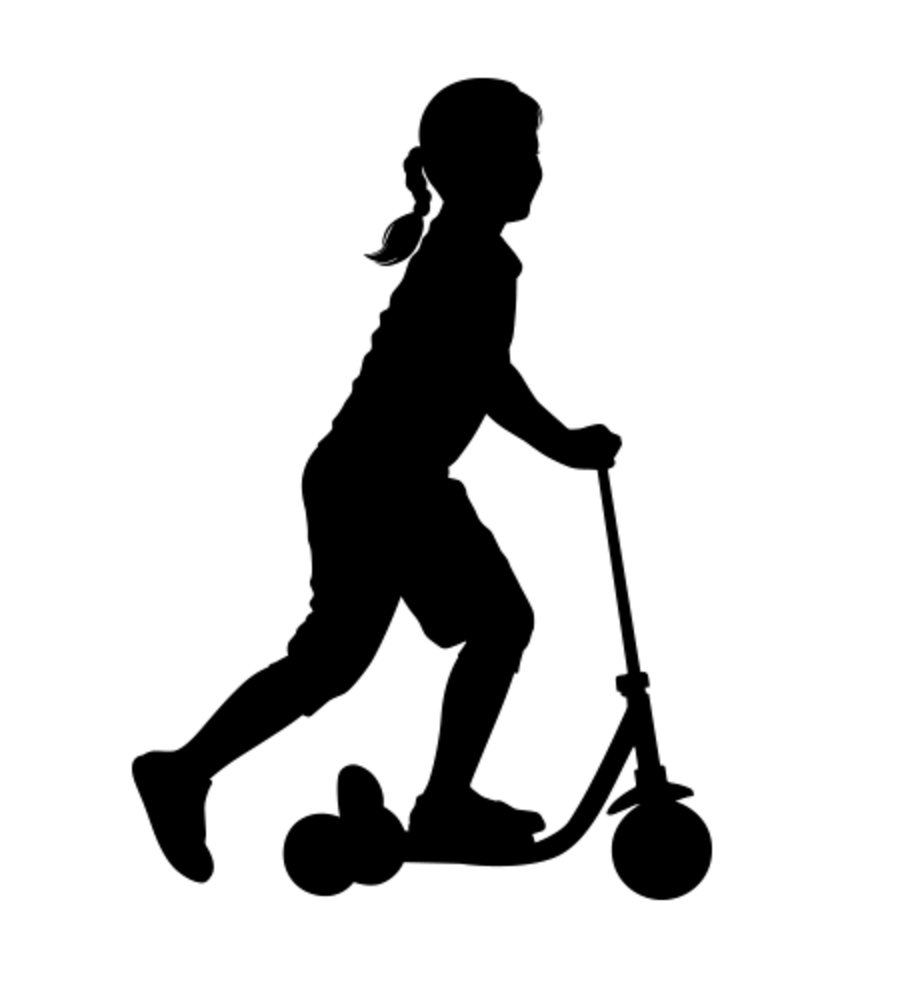
Younger kids don’t always get that the tricycle is considered “put away” when it’s next to the closet rather than in the middle of the room. Great tip: Get a a can of house paint in your child’s favorite color, and paint a silhouette on the wall for oddly shaped and oversized toys, that will show your kids where in the room you expect them to be put away.
To do this, first put all the toys in their place. Then, with a pencil, trace an outline of each toy (like a scooter, rocking horse, giant dollhouse, yoga ball) on the wall, and then paint inside the outline. When it’s time to tidy up, putting away those bigger toys will feel more like finishing a puzzle for kids, than an annoying task. Another option is using wall decals like this girl on a scooter from Vinyl Silhouettes.
7. Get a shovel. Yes, really!

When the kids’ rooms have turned into a total pigsty — as they inevitably will from time to time — the quickest way to manage the mess is to scoop up all the toys into a large pile in the middle of the room, pull up a chair, and sort. (Or better, have them sort.)
A plastic beach spade, or a kid-sized shovel like this one from Melissa & Doug, makes it really easy to gather up puzzle pieces, crayons, blocks, and all the little bits and bobs that belong to different playsets. Then just pull the relevant toy bins and have your kiddos help declutter their own messes and put items away where they belong. You can even have them decorate their shovel with paints or Sharpies, or add their own personalized labels, and the kids will really get into using the “bedroom scooper” to clean up their toy explosions.
A huge thank you to Emma Gordon at Clutter.com for her helpful decluttering tips for parents. Here’s to hoping they work for lots of you!
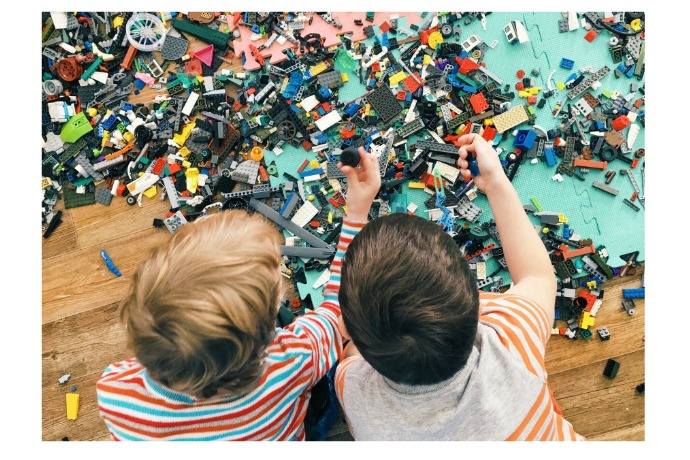






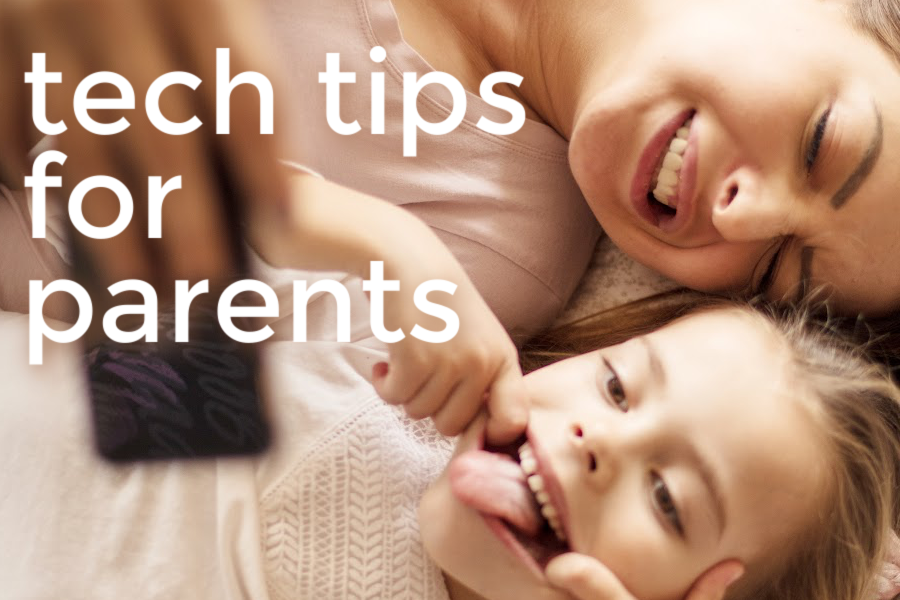
That is a nice list of stuff to do. I am guessing that the kids are still “kids”. Once they get to the know-it-all age, we start seeing the attitudes. I am sure many can relate. I do like the fancy crafts though and the lego picture at the beginning of the post got me. I am still in love with legos. I think they made me believe that anything once built can always be built again and that likewise anything once broken can always be broken again!
When I wear my pediatrician hat, I assume I can make kids cooperate but when the emotional connection of being their parent kicks in, there is sometimes a short-circuit. I recently wrote a post about getting children to behave well for their parents but it still “all depends” or as we say on Facebook “It’s complicated”.
Thanks for the post. Very well written.
This is an amazing article! Being a Mommy Blogger and a Stay at Home Mom, I see a lot of messes! (Especially from my 2 year old boy!) I will definitely be using some of these ideas! Some of these tips are things I had never even thought existed! Thank you for writing this post. 🙂
Excellent tips. I love storage ideas that show the kids what goes where since the biggest complaint I hear is “But I don’t know where it goes” – which is just a symptom of being overwhelmed. Any clues we can give the kids help them be self reliant when it comes to clean up.